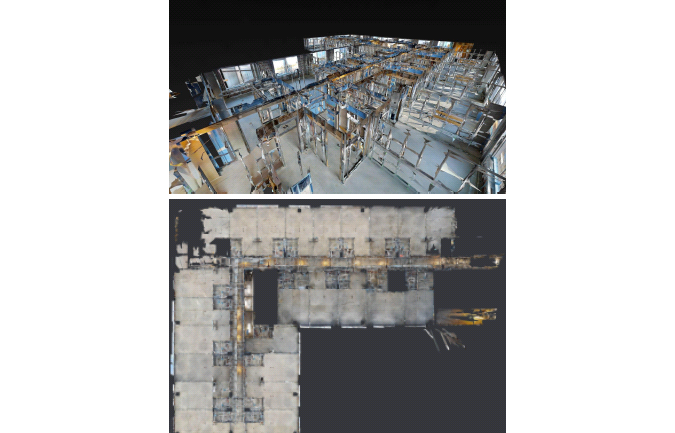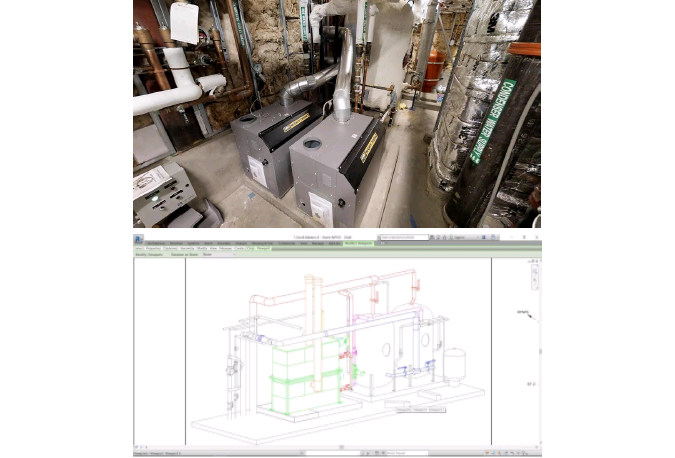Professionals across the architectural, engineering and construction disciplines have long understood the importance of visualisation in planning and executing building projects. Visual tools such as drawings, photos and more recently 3D scanning, imagery and computer-generated models enable architects, contractors and owners to develop deep understanding of on-site conditions. Accurate information is essential in developing designs and strategies to produce great results.
(Matterport带给您本文)
But high quality imagery and 3D data is not easy to come by. The need to capture and share realistic visual data has driven a series of significant technological advances.
In recent years, immersive technologies have emerged as an important new component in the AEC toolbox. These specialized tools are used to capture and present a spatially accurate 3D representation of a project space. The approach enables stakeholders to remotely experience a scene with accurate context and detail. As a result, immersive technologies are becoming a key part of efficient, precise communication and collaboration throughout the design/build/operate process.

Matterport blends technologies for 3D scanning and imaging with a cloud-based approach to data processing and information sharing. The solution creates immersive 3D models that let people feel like they are on the project site. Matterport’s approach provides high levels of detail and efficiency while significantly reducing the cost and complexity commonly associated with immersive technology solutions.
将工作岗位带到办公室
沉浸式技术使利益相关者能够体验一个项目地点,而无需花费时间和费用前往现场。该值远远超出了虚拟场地访问。
现实捕获的技术为测量,分析,计划和长期管理提供了丰富的环境。综合信息构成了基于准确,及时信息的更快响应和决策的基础。结果是成本较低,风险降低和信息交换更有效。
Opportunities for immersive technology exist throughout the AEC arena. We can identify three areas where Matterport solutions are adding value:
Project Planning and Design
在项目开始时,建筑师和工程师需要有关现有条件的准确信息。诸如改建,扩展和改造新设备之类的项目中,使用了包括3D图像和点云在内的原生成信息。这对于住宅,商业和工业应用是正确的。
Reality capture and immersive technologies are key enablers for today’s world of virtual teams. They produce detailed as-built information that can be easily shared among downstream systems and users. Attendees at virtual meetings can interact with the data in real time, with everyone seeing the same views of the project. The immersive solutions also enable technicians to extract additional information without revisiting a site, an important consideration in today’s world of remote projects. When questions come up during design, the answers are just a few clicks away.

建造
身临其境的技术起着关键的作用在减少risk on construction projects. By capturing and sharing 3D information, contractors can conduct frequent inspections and updates with minimal disruption to the jobsite. The timely inspections help teams spot potential problems sooner and prevent expensive surprises later in the project.
Contractors can also use reality capture to produce construction documentation, such as progress milestones and quality control reports. Using 3D visualization, project stakeholders can “visit” a site from any location. Issues related to costs and scheduling for travel to project meetings are significantly reduced, and meetings can take place with greater frequency and flexibility. Shared visualization ensures clear, efficient communication and informed decisions.
Reality capture adds significant value as contractors prepare turnover packages. 3D imagery supports efficient management of final inspections and punch lists. Any issues can be tagged for resolution. Turnover packages can also provide documentation of the site during construction. For example, 3D imagery and models captured during construction can show the location of MEP components that are concealed inside finished walls. Building owners can use the information for maintenance and in planning future work that ties into the hidden fixtures.
设备管理
During the operational portion of a building’s life cycle, managers need accurate information on the structure and its contents. In addition to construction documents and turnover packages, Matterport’s immersive technology can supply precise information as facilities age over time, including remodels and changes to installed equipment.
This lifecycle information extends beyond images. For example, by using Matterport’s Mattertag™ Posts functionality, users can attach non-visual information directly to individual objects. Maintenance records, sourcing information, user manuals and other information—including links to documentation stored on external servers—can be accessed directly from the Matterport model.

Immersive technology can also aid in planning lifecycle activities. For example, 3D data can not only confirm that new equipment will fit into a space but it can also help in planning the installation. Contractors can use 3D models in determining the best routes for moving and removing large items through the facility.
Eliminating Barriers
Immersive technology provides important benefits, but it comes with some challenges. Workflows for 3D data capture, processing and delivery have traditionally been costly. Field hardware such as laser scanners are expensive and require highly trained personnel. In the office, data processing is time consuming and relies on dedicated technicians operating complex software. When the processing is completed, downstream users may need specialized tools to view and utilize the point clouds and images. These barriers have prevented many organizations from adopting 3D data capture and visualization.
Matterport用三种方法来解决这些问题。First, the Matterport solution uses a simple, low-cost approach to capture detailed images and 3D data on a jobsite. The Matterport Pro2 3D camera completes a scan in less than 30 seconds. For many sites, data capture that requires hours using a laser scanner can be completed quickly with Matterport. In comparison testing, the Matterport system can reduce capture time on site by up to 75 percent over manual methods. The system requires minimal training and can be operated by trades workers or interns without tying up high cost professional staff. The Matterport Capture app running on an iPad tablet guides the operator through the process. Before leaving the jobsite, the Capture app provides immediate confirmation that the data is complete.

其次,MatterPort管理和处理数据以产生高质量的结果。数据捕获完成后,捕获应用程序使将字段数据易于将其上传到Matterport Cloud,并将其分析并处理为3D图像和点云。
此步骤代表了在常规扫描和摄影测量法上节省的大量时间和成本。MatterPort用户可以在绕过投资昂贵的软件和培训的需求的同时,提供全面的信息。尽管常规方法通常需要许多操作员来处理数据并产生干净的点云和图像,但MatterPort解决方案完全消失了。一个典型的Matterport项目已准备好在上传数据后大约两个小时查看和交付,而没有操作员交互。
Finally, the Matterport solution includes tools and output that extend the immersive experience to downstream users. The system allows stakeholders to conduct virtual walkthroughs and see jobsite conditions from any angle or location. Simple browser-based viewers and measurement tools enable users to easily extract information.
为了进行更详细的分析,MatterPort输出包括点云,图像,平面图和反映天花板计划。MatterPort使用通用格式来确保将数据导出到广泛使用的BIM和设计系统,包括Autodesk®Recap™,Revit®和Sketchup。
为了进一步扩展沉浸式技术的使用,Matterport已为定制开放解决方案。它的硬件敏捷策略支持使用第三方设备,例如Leica BLK360扫描仪。
In the office, developers can use Matterport’s software development kit (SDK) to create customized applications running on the Matterport platform. The approach enables users to utilize Matterport’s low-cost 3D models and imagery in task-specific software.

The High Value, Low-Cost Game Changer
The value of immersive technologies—cost savings and productivity realized through accuracy and shared visualization—is attracting attention across and beyond the AEC community. As public awareness of the technology continues to grow, expectations will rise and 3D visualization will become the norm. Project owners will rely on their architects, engineers and contractors to provide timely, comprehensive 3D information.
但是,许多AEC提供商可能会遇到现实捕获的障碍:费用,复杂性和时间。到目前为止,这些担忧将大部分工作推向了大型AEC公司,测量师和专业服务提供商。
Matterport通过其简单,自动化的方法来攻击了这个问题,以实现现实捕获,数据处理和信息共享。MatterPort平台使越来越多的AEC专业人员能够比其他技术更快地提供高价值可交付成果。通往3D信息的门是敞开的。
John Chwalibog是AEC解决方案的主管Matterport Inc.

